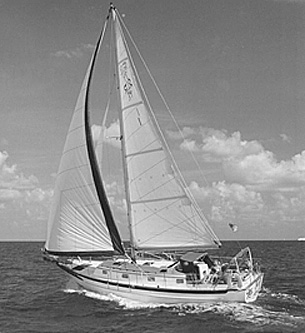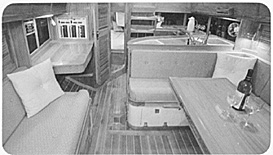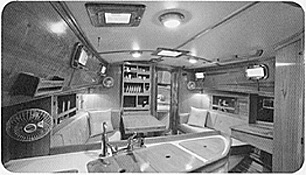New Boat Review:
The Cabo Rico 34
Underway /
Construction
/
Conclusion
by Captain Thom Burns
 Perhaps
the most realistic method to review a cruising yacht is to live on it. When
Gunnar of Gunnar’s Yacht & Ship suggested staying aboard his new Cabo Rico 34 as
part of our review, I thought “Yes, I will get a feel for this yacht, hopefully,
as its potential owner will use it.” Since I had to be in Chicago and Milwaukee,
splitting the difference in picturesque Racine, Wisconsin would be ideal.
Perhaps
the most realistic method to review a cruising yacht is to live on it. When
Gunnar of Gunnar’s Yacht & Ship suggested staying aboard his new Cabo Rico 34 as
part of our review, I thought “Yes, I will get a feel for this yacht, hopefully,
as its potential owner will use it.” Since I had to be in Chicago and Milwaukee,
splitting the difference in picturesque Racine, Wisconsin would be ideal.
I had seen the Cabo Rico 38 at the Annapolis Boat Show where its beautiful
lines and long lines to view it impressed me. As Gunnar and I approached the
Cabo Rico 34, I noticed how strikingly beautiful the boat actually is. It’s
lines, ports, cutter rig, and wood all point to a traditional boat but its not
quite that way. The width of the boat, the shape of the stern, the stern rail
seats and the cut-away full keel which I knew was below the forward quarter of
the boat indicate a modern flare. The designer,W.I.B. Crealock, has tried to
provide enough volume for comfort and to add seakindly performance.
When you step into the cockpit there is just enough teak for elegance. This
particular boat has a green dodger and canvas covers which accent both the teak
and the cream colored hull nicely. The seats are deep and high for comfort. The
transom is closed for offshore. Looking forward on deck I noticed the quality
hardware and the large dorade vents built in boxes with rails around them to
protect them and provide an extra handhold if needed. Below decks this same vent
has an adjustable, sliding, offset opening, one of many small but important
details for the offshore cruiser. The decks and coach roof are uncluttered. The
foredeck is large for a 34 foot boat and the bowsprit extends another three plus
feet. Looking down you’ll notice how fine the bow entry is on this relatively
wide beam of eleven feet which is carried way aft. From the cockpit you must
step up to descend the companionway ladder, another offshore detail.
As you descend the ladder the steps on both sides are cantilevered for easy
use when heeled. The wood is a lighter honey colored golden teak of Costa Rica
throughout. The U-shaped galley is complete with a stainless steel double sink,
two burner gas stove with oven, hot and cold pressure water, a six cubic foot
icebox with refrigeration and plenty of lockers and drawers for incidentals.
Five Lewmar hatches, the two dorade vents mentioned earlier, and eight opening
ports provide ventilation and light. The hull and deck are completely insulated.
It was in the high eighties during the day when I was aboard. Many boats would
have been like an oven. The Cabo Rico was not. It freshened and cooled in a few
minutes with the opening of half the ports and hatches.
The boat has two full double sleeping cabins, one fore, the other aft to
starboard. A third double pulls out using a shelf under the settee. Access to
storage under the settees is not by pulling cushions up, sliding a plywood cover
off and digging into the void, it is by a drawer which pulls out. The doors and
cabinetry are solid teak with fine joinery. Even the hanging lockers are vented.
The nav table is starboard across from the galley facing aft. This is a very
fine station for a thirty-four footer. The vertical panels forward and outboard
of the station fold down for access to the electrical boards.
Underway
| Per Gunnar trimming the genoa off Racine,
Wisconsin. |
 One
of the differences with the cut-away full keel is that the boat handles well
under power, much better than a traditional full keel and steadier than many fin
keel boats of about the same size. We sailed the Cabo Rico 34 under its most
adverse conditions, in light breezes from 3 to 10 knots on a beautiful, sunny
morning just off Racine. Like most full-keel boats, the cut-away full keel
tracks very well. Gunnar, who is also a rigger, set the boat up to have a three
degree helm. It was perfectly balanced in wind conditions from 3 to 10 knots on
all points of sail. In fact, we would routinely let the helm go as we talked or
walked around the boat. The Cabo Rico 34 never ventured more than 3 degrees from
its original course. Joshua Slocum told the world that he set his “Sprite” to
sail by herself for hours. Gunnar did the same thing to the Cabo Rico, at least
in light winds.
One
of the differences with the cut-away full keel is that the boat handles well
under power, much better than a traditional full keel and steadier than many fin
keel boats of about the same size. We sailed the Cabo Rico 34 under its most
adverse conditions, in light breezes from 3 to 10 knots on a beautiful, sunny
morning just off Racine. Like most full-keel boats, the cut-away full keel
tracks very well. Gunnar, who is also a rigger, set the boat up to have a three
degree helm. It was perfectly balanced in wind conditions from 3 to 10 knots on
all points of sail. In fact, we would routinely let the helm go as we talked or
walked around the boat. The Cabo Rico 34 never ventured more than 3 degrees from
its original course. Joshua Slocum told the world that he set his “Sprite” to
sail by herself for hours. Gunnar did the same thing to the Cabo Rico, at least
in light winds.
This boat moves really well. We routinely sailed half the true wind speed in
a cut-away full keel boat weighing 15,500 lbs.! Its pointing ability is
surprising. I would say 33 to 34 degrees apparent was about right. The fore
triangle is relatively large for a cutter permitting the use of large
lightweight headsails for an extra turn of speed.
This is not a boat you would want to get into a tacking dual with on the race
course because with all its weight it powers up slowly. But for a seakindly,
smooth ride across vast stretches of the Great Lakes and beyond it could be a
cruiser’s dream.
Construction
 Gunnar invited
me to look everywhere at the construction of the boat. Structural bulkheads help
to remove any tendency of a hull and deck to flex, a condition which can cause
stress cracks over time. On the Cabo Rico, bulkheads are glassed and clad in
solid teak for strength and then fully bonded to both hull and deck using 3
layers of 1.5 oz. mat and 3 layers of 24 oz. roving.
Gunnar invited
me to look everywhere at the construction of the boat. Structural bulkheads help
to remove any tendency of a hull and deck to flex, a condition which can cause
stress cracks over time. On the Cabo Rico, bulkheads are glassed and clad in
solid teak for strength and then fully bonded to both hull and deck using 3
layers of 1.5 oz. mat and 3 layers of 24 oz. roving.
The hull to deck joint, one of the most important to guarantee structural
integrity is a raised bulwark design. This design creates a large “U” channel
 structure around the entire vessel. This form reduces the “twist” factor. The
joint is sealed and thru bolted throughout. This design has the added benefit of
providing a vertical platform for attaching lifeline stanchions. This is both
stronger and less likely to leak.
structure around the entire vessel. This form reduces the “twist” factor. The
joint is sealed and thru bolted throughout. This design has the added benefit of
providing a vertical platform for attaching lifeline stanchions. This is both
stronger and less likely to leak.
Cabo Rico uses an elaborate mast step bridge which elevates the mast butt to
the dry cabin sole. This allows for an effective keel stepped mast while never
allowing the mast butt to come into contact with potentially corrosive bilge
water. The bridge itself is of heavy fiberglass laminate in a crisscross
pattern, with a half inch aluminum plate laminated into the top covering
fiberglass platform. The solid teak and holly sole is epoxied to the covering
platform giving a uniform finished area to which the mast step is through
bolted. The void is used for the holding tank.
The cabin sole or floor construction on this boat is elaborate. All floor
stringers transfers and sub-flooring are solid fiberglass. The solid teak and
holly sole is attached with epoxy glue. There is no area of the bilges and
substructure that is wood or that can rot under any conditions.
While I was poking around the bilges I found a complete grounding system
using heavy industrial wire and connections and a totally encased keel. You
could actually reach things under the engine as well as on all sides. This boat
is overbuilt by production boat standards from the keel up. I would recommend
using the design and construction detail of the Cabo Rico as a good comparison
model when shopping boats.
Conclusion
This boat will satisfy its owners in so many ways. It will sail the Great
Lakes and oceans of the world in splendid, seakindly and most importantly in a
seaworthy manner. It’s built forever, place it in your sailing trust fund. It
would surely make an elegant, nautical B & B on Pier 39 in San Francisco. As
Gunnar said, one of the main differences in construction and details is the
hours Cabo Rico can afford to devote to building the boat from their base in
Costa Rica. The company claims they put more hours into building the hull than
many builders put into building their entire boat. I believe them. This boat
must be seen to be fully appreciated. After you see it your dreams will be
rekindled. Clear Great Lakes waters, Caribbean emerald reefs and crystal,
pacific lagoons will beckon you as it did Leo Ramer, a novice at 63 who bought
his first boat, a Cabo Rico 34, and set out on an extended trip that helped him
start living fully again after a personal tragedy.
Captain Thom Burns publishes Northern Breezes and Sailing Breezes.
Cabo Rico Yachts
GUNNAR’S YACHT & SHIP, P.O. Box 35, Racine, WI 53401-0035,
(262) 639-0238.
CABO RICO YACHTS, INC., 2258 SE 17th St., Ft. Lauderdale, FL 33316,
954-462-6699.
-
About Sailing
Breezes Magazine
Please send us your comments!!
All contents are
copyright (c) 1997 by Northern Breezes, Inc. All information contained within is
deemed reliable but carries no guarantees. Reproduction of any part or whole of
this publication in any form by mechanical or electronic means, including
information retrieval is prohibited except by consent of the publisher.
 Perhaps
the most realistic method to review a cruising yacht is to live on it. When
Gunnar of Gunnar’s Yacht & Ship suggested staying aboard his new Cabo Rico 34 as
part of our review, I thought “Yes, I will get a feel for this yacht, hopefully,
as its potential owner will use it.” Since I had to be in Chicago and Milwaukee,
splitting the difference in picturesque Racine, Wisconsin would be ideal.
Perhaps
the most realistic method to review a cruising yacht is to live on it. When
Gunnar of Gunnar’s Yacht & Ship suggested staying aboard his new Cabo Rico 34 as
part of our review, I thought “Yes, I will get a feel for this yacht, hopefully,
as its potential owner will use it.” Since I had to be in Chicago and Milwaukee,
splitting the difference in picturesque Racine, Wisconsin would be ideal. One
of the differences with the cut-away full keel is that the boat handles well
under power, much better than a traditional full keel and steadier than many fin
keel boats of about the same size. We sailed the Cabo Rico 34 under its most
adverse conditions, in light breezes from 3 to 10 knots on a beautiful, sunny
morning just off Racine. Like most full-keel boats, the cut-away full keel
tracks very well. Gunnar, who is also a rigger, set the boat up to have a three
degree helm. It was perfectly balanced in wind conditions from 3 to 10 knots on
all points of sail. In fact, we would routinely let the helm go as we talked or
walked around the boat. The Cabo Rico 34 never ventured more than 3 degrees from
its original course. Joshua Slocum told the world that he set his “Sprite” to
sail by herself for hours. Gunnar did the same thing to the Cabo Rico, at least
in light winds.
One
of the differences with the cut-away full keel is that the boat handles well
under power, much better than a traditional full keel and steadier than many fin
keel boats of about the same size. We sailed the Cabo Rico 34 under its most
adverse conditions, in light breezes from 3 to 10 knots on a beautiful, sunny
morning just off Racine. Like most full-keel boats, the cut-away full keel
tracks very well. Gunnar, who is also a rigger, set the boat up to have a three
degree helm. It was perfectly balanced in wind conditions from 3 to 10 knots on
all points of sail. In fact, we would routinely let the helm go as we talked or
walked around the boat. The Cabo Rico 34 never ventured more than 3 degrees from
its original course. Joshua Slocum told the world that he set his “Sprite” to
sail by herself for hours. Gunnar did the same thing to the Cabo Rico, at least
in light winds. Gunnar invited
me to look everywhere at the construction of the boat. Structural bulkheads help
to remove any tendency of a hull and deck to flex, a condition which can cause
stress cracks over time. On the Cabo Rico, bulkheads are glassed and clad in
solid teak for strength and then fully bonded to both hull and deck using 3
layers of 1.5 oz. mat and 3 layers of 24 oz. roving.
Gunnar invited
me to look everywhere at the construction of the boat. Structural bulkheads help
to remove any tendency of a hull and deck to flex, a condition which can cause
stress cracks over time. On the Cabo Rico, bulkheads are glassed and clad in
solid teak for strength and then fully bonded to both hull and deck using 3
layers of 1.5 oz. mat and 3 layers of 24 oz. roving. structure around the entire vessel. This form reduces the “twist” factor. The
joint is sealed and thru bolted throughout. This design has the added benefit of
providing a vertical platform for attaching lifeline stanchions. This is both
stronger and less likely to leak.
structure around the entire vessel. This form reduces the “twist” factor. The
joint is sealed and thru bolted throughout. This design has the added benefit of
providing a vertical platform for attaching lifeline stanchions. This is both
stronger and less likely to leak.